There are 35 companion plants for Azaleas in this list which cut across plants like shrubs, flowers, Ferns, Hosta, and, surprisingly, trees. This is because azaleas are a flower that goes with almost all other flowers and can also serve as a very good background aesthetic filler for large plants. So now, read more about Azaleas themselves.
Azaleas are deciduous flowering shrubs of the genus Rhododendron that bloom in early spring and persist for approximately three weeks before losing petals or leaves to signify that it is time to go back to sleep. They are lovely but short-lived blooms that only endure around six weeks after blossoming.
Azalea blooms are funnel-shaped, two-lipped, and frequently fragrant. Rhododendron flowers, on the other hand, are frequently bell-shaped. Azalea blooms normally have five protruding stamens, but rhododendron blossoms have 10 (or more). They are also members of the Ericaceae family.
Azalea flowers change color over time, ranging from white to numerous pink, red, yellow, orange, and salmon hues. Thriving in partial to full shade, azaleas are a great choice for gardeners looking to add year-round interest with a large shrub that prefers well-drained acidic soil (4.5–6.0 pH) conditions for best results. Fertilizer requirements are minimal. Some plants require frequent trimming. The majority of types look best in a shady or wooded border or in containers. Azaleas should be grown indoors in a cool, well-ventilated area, such as a conservatory, in bright light but not direct sunlight. All azaleas demand wet but well-drained, humus-rich, neutral to acidic soil.
Azalea shrubs are toxic in all varieties and components. They include grayanotoxins, which are poisons. Eating the plants’ leaves, nectar, or blooms can also be hazardous. As a result, they are mostly planted for their lovely blooms and ornamental purposes. Flowers, on the other hand, are analgesic, anesthetic, and sedative. Externally, they are used to treat arthritis, cavities, itch, maggots, and severe injuries. The root also treats arthritis, rheumatism, and severe injuries.
Table of Contents
Like any other plant, azalea has its own disease and pests that impact its growth and appearance in the garden. Azalea diseases and pests include Botryosphaeria canker, Botrytis blight, Cercospora leaf spot, leaf and flower gall, Phytophthora root rot and top dieback, Powdery mildew, Ovulinia petal blight, Cylindrocladium blight.
As a good gardener, one of the greatest ways to combat them is to use companion planting with the plants, which may also apply to Azaleas. Although virtually all of the azalea companion plants are primarily for aesthetic and decorative purposes, some also contribute to preventing and controlling these diseases and pests.
So, in this article, we will go over thirty-five (35) good companion plants for azaleas and two (2) bad companion plants for azaleas, as well as how they affect azaleas favorably or adversely.
Good Companion Plants For Azaleas
Choosing the right companion plants, such as encore azaleas, spring bulbs, and ground covers, can create a perennial garden filled with different colors and textures. Ideal companion plants like the plantain lily and Japanese forest grass add visual interest with their dense foliage, complementing the azalea’s delicate blooms in early summer.
1. Abelias

- Botanical Name: Abelia grandiflora
- Sun Requirements: minimum of 6 hours of direct sunlight
- Soil Type: Loamy, Moist but well-drained
With their pink flowers blooming alongside azaleas, Abelias are a popular choice for adding a pop of color to garden beds in shady areas.
Abelias are a flowering plant hybrid in the honeysuckle family. It is a multi-stemmed deciduous or semi-evergreen shrub with rounded, spreading, or elegantly arching branches. The fragrant blooms are produced in clusters, white, tinted pink, bell-shaped, and reasonably easy to maintain.
Abelias is an excellent azalea companion because of its magnificent masses of blooms that contribute to the attractiveness of your yard. Also, Abelias thrive in a sunny but protected location in well-drained soil. With glossy foliage, it’s easy to understand why it’s a gardener’s favorite.
2. Astilbes
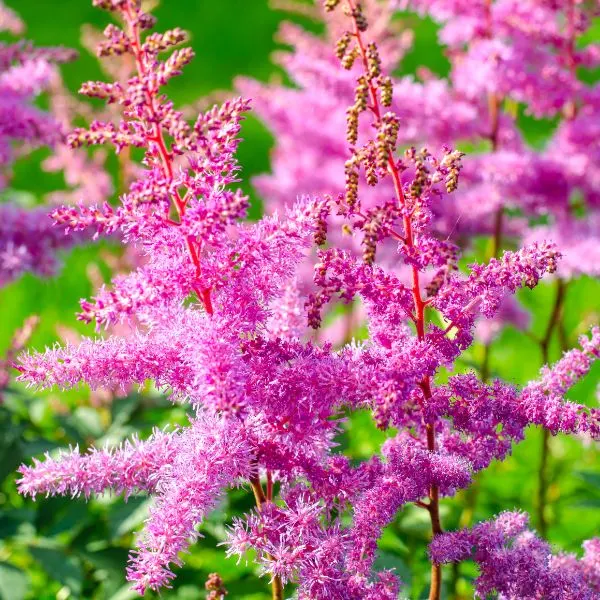
- Botanical Name: Astilbe chinensis
- Sun Requirements: light to moderate shade, but deep shade will result in few and poor flowers
- Soil Type: well-drained and rich in organic material
Astilbes, with their lush foliage, serve as great companion plants for azaleas, thriving under similar soil conditions and partial shade.
Also known as fake goat’s beard, a tall false beard, buck’s, or Chinese astilbe, is a saxifrage plant. It is a perennial plant that grows along shady streams and rivers. It is also often planted for decorative reasons in shady gardens.
Astilbes, like Azaleas, love acidic soil; therefore, planting them alongside astilbe beneath the shade of a pine tree is advantageous since it makes care much easier and adds to the visual attractiveness of your garden. However, pruning azaleas after blooming is recommended for healthy development the next season.
3. Barberry
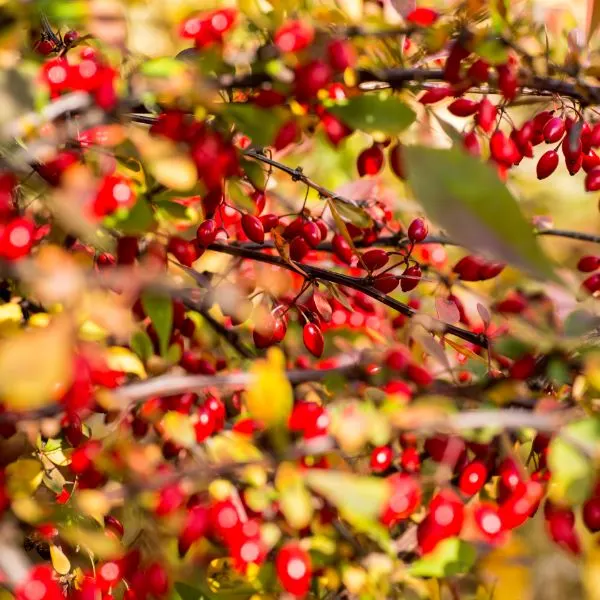
- Botanical Name: Berberis microphylla
- Sun Requirements: minimum of 6-7 hours of direct sunlight
- Soil Type: loamy, well-draining soil
Barberry bushes, with their bright red berries and dense foliage, offer a different texture and color contrast, making them a great option for a beautiful garden when planted alongside azaleas.
Commercially, it is produced for its fruit, putative medicinal benefits, and as a garden plant or bonsai. The wood of this tree is used to manufacture a crimson dye.
Barberry is a versatile and useful shrub that may make your azalea landscape stand out. This plant produces red and gold winter fruit that attracts pollinators. It’s simple to cultivate and great for borders or hedges in the garden. They require the same growth conditions as azaleas.
They are, nevertheless, resilient and grow quickly with little effort. Because of their fruit, barberry shrubs make excellent hedges and are popular among wildlife.
4. Bleeding heart
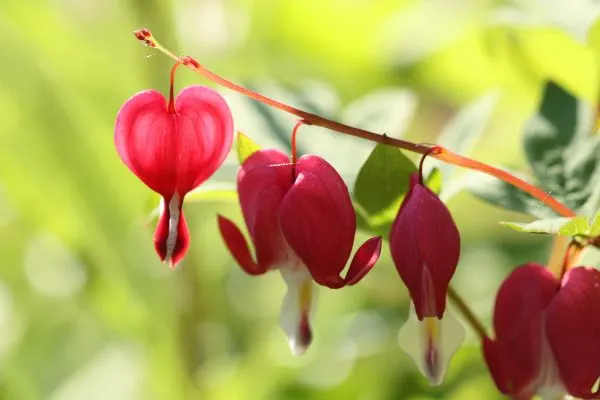
- Botanical Name: Lamprocapnos spectabilis
- Sun Requirements: less than five hours of direct sun each day
- Soil Type: humus-rich, moist, well-draining soil with lots of organic matter
Bleeding heart, also known as Fallopian buds, is a blooming plant of the poppy family. It is prized in gardens and floristry for its heart-shaped pink and white blooms that bloom in spring; it is also often planted for ornamental purposes.
Azaleas give the right shady circumstances for bleeding hearts. On the other hand, bleeding Hearts die back during the hot summer months, making a place for other plants. Then, in early spring, around the same time as azaleas, they return to bloom with delicate stalks of crimson hanging, heart-shaped blooms. They return and bloom with delicate stalks of red-hanging, heart-shaped blossoms.
5. Blueberry

- Botanical Name: Vaccinium angustifolium
- Sun Requirements: six to eight hours of sunlight.
- Soil Type: sandy but with high levels of organic matter
Blueberry, sometimes known as wild lowbush blueberry, is a widely dispersed and ubiquitous species of perennial blooming plants with blue or purple berries. Lowbush blueberries are smaller and sweeter, and as a result, they are frequently utilized in jams and jellies.
Azaleas attract vital pollinators, including hummingbirds and bees, who love to browse the lovely blooms of the Blueberries for their sweet-tasting nectar, which can enhance berry production since they encourage these insects to visit the blueberry bushes as well.
Azaleas thrive in rich, organic soil that is very acidic, and they can survive in either full sun or moderate shade, so you may plant them in areas of the garden where blueberries may not grow.
The vivid blossoms of R. occidentale, often known as the Western azalea, may create a striking accent when planted alongside blueberry bushes. Furthermore, azaleas may give much-needed shade to blueberries during the hot summer months.
Azaleas may also reach heights of 150cm. It is ideal for trimming them somewhat once they have completed flowering, not only to stimulate new growth the next season but also to lessen their height and give more direct sunshine to your blueberry bushes.
Azaleas and blueberries may coexist as long as they are kept sufficiently separated.
6. Boxwoods

- Botanical Name: Buxus sempervirens
- Sun Requirements: five to six hours of full sun per day
- Soil Type: well-drained soil, sandy loam
Boxwood is a genus containing over seventy species in the Buxaceae family. Box and Buxus are two common names. They are evergreen shrubs and tiny trees with a moderate growth rate. Because of the slow growth of boxwood, it becomes very hard (possibly the hardest in Europe) and heavy; the wood is yellow in color and has no grain caused by growth rings, making it perfect for cabinet-building, the fabrication of flutes and oboes, marquetry, engraving, woodturning, tool handles, and mallet heads, and as a substitute for ivory.
Boxwoods may be kept at the proper height with minimal trimming. They also shelter Azalea bushes from the intense afternoon sun. They are incredibly adaptable and may thrive in full sun if the planting site is modified. Boxwood is a slow-growing plant that may be cut or trimmed frequently without dying back.
7. Camellias
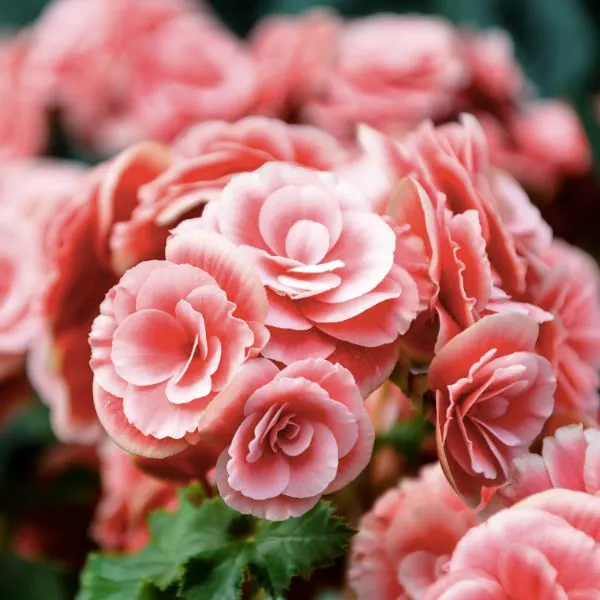
- Botanical Name: Camellia japonica
- Sun Requirements: 4–6 hours of full sun each day
- Soil Type: consistently moist, slightly acidic, organically rich, well-drained soils
Camellias, often known as common camellia or Japanese camellia, is a flowering plant genus in the Theaceae family. It is a blooming tree or shrub used in traditional Japanese, Chinese, and Korean medicine to cure stomach sickness, bleeding, and inflammation.
These evergreen glossy-leafed plants are among the most beautiful. They create beautiful shrub borders but may also be planted in pots with your azaleas.Camellias, like azaleas, are acid-loving plants that enjoy a pH range of 5.0 to 5.5. They get along with other plants with similar preferences.
8. Columbines
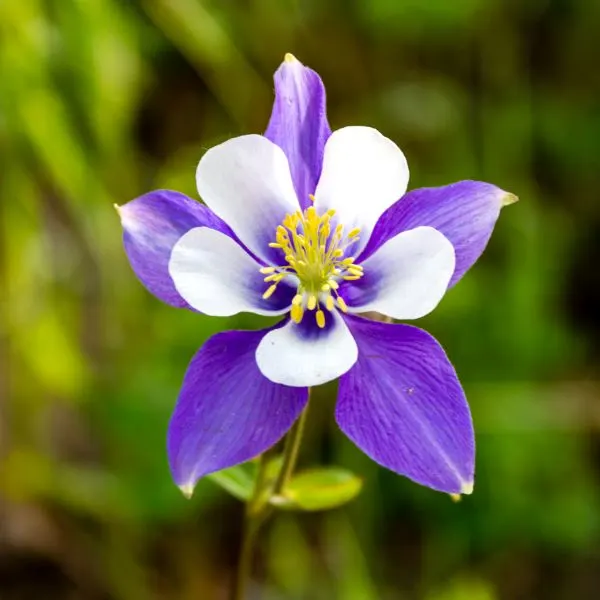
- Botanical Name: Aquilegia vulgaris
- Sun Requirements: Less than six hours a day
- Soil Type: well-drained soil but prefer slightly acidic garden soil
Columbines, sometimes known as granny’s bonnet, is a genus of 60-70 species of perennial plants found in meadows, forests, and higher elevations. Columbine is a hardy perennial that reproduces by seed and is distinguished by its spurred petals. However, due to the severe toxicity of this plant’s seeds and roots, medicinal use of its seeds and roots is best avoided; columbine poisonings can be deadly.
Columbines have exquisite multi-colored blossoms on thin stalks. Planting this flower in your Azalea garden can attract beneficial pollinators such as hummingbirds and butterflies. Its lovely blossoms also enhance the attractiveness of your Azalea garden. The vivid colors of columbine make it a welcome addition to any garden.
9. Coral Bells
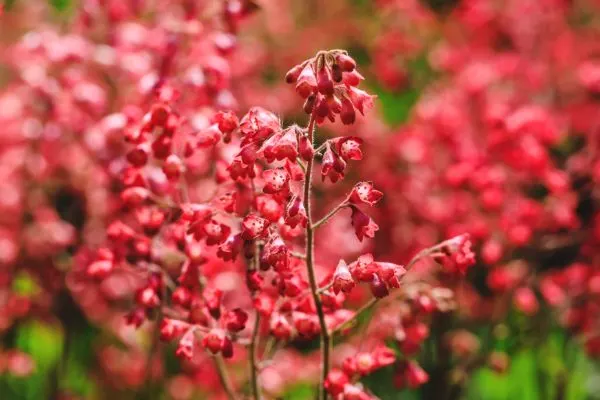
- Botanical Name: Heuchera sanguinea
- Sun Requirements: 4 to 6 hours of direct sunlight per day
- Soil Type: Loamy or sandy soil, as well as clay, if improved with organic matter and grit
Azaleas complement Coral Bells well. These lovely shrubs are like somewhat acidic, humus-rich, well-draining soil. They are drought-tolerant as well as pest and disease resistant.
Heucheras are well-known for their compact, low mounds of leaves in a variety of vibrant hues. They have a woody base and produce little bell-shaped blooms on long, graceful stalks, making them wonderful cut flowers. Azaleas require a thick layer of mulch to keep moisture in until they are well established.
Azaleas may provide you with some magnificent blossoms in the middle to late spring. The dwarf azalea may grow to be less than three feet tall, producing clusters of bell-shaped or tubular blooms in a range of hues, and thrives in USDA hardiness zones 6b – 8a, depending on the type.
Dwarf variations work best when combined with heuchera. Make sure your USDA zone is right before selecting an azalea. If you can find one that will grow in your location, you will discover that the azalea complements the coral bell nicely since their colors and textures complement each other so well.
10. Cranberry
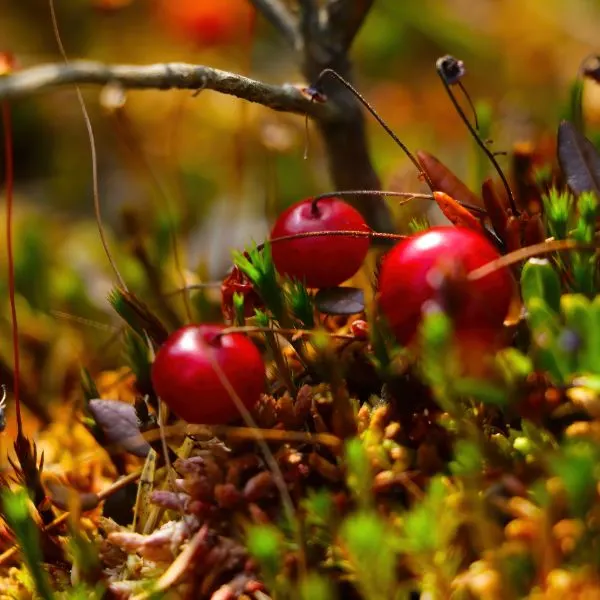
- Botanical Name: Vaccinium oxycoccos
- Sun Requirements: six to eight hours of sunlight daily
- Soil Type: Acidic soil that drains well
Cranberry is a flowering plant species in the heath family. It is also known as small cranberry, bog cranberry, marsh berry, and swamp cranberry. The berries are edible and have been utilized by numerous Native American groups as both medicine and sustenance.
Azalea flowers are a great way to bring subtle flashes of color to your home and garden areas. They also draw important pollinators to your cranberry trees. Berries may not grow if they are not pollinated properly. Cranberries may also be used as a ground cover in your Azalea garden.
11. Daffodils

- Botanical Name: Narcissus poeticus
- Sun Requirements: at least six hours of direct sun per day
- Soil Type: loose, loamy, fertile, and, most of all, well-draining soil
Daffodil is a genus of mostly spring-flowering perennial plants in the amaryllis family. The blooms are typically white and yellow (but can sometimes be orange or pink in garden versions), with either uniform or contrasting colored tepals and corona.
Daffodils are one of the most visible heralds of spring. They will bloom year after year with little upkeep once planted.
This is an excellent opportunity to create some visual candy. Azalea flowers in pastels and spring hues look especially nice next to yellow, red-orange, and cream blossoms and Daffodil bulbs in spring, with trees and blue sky in the backdrop.
Although, If you wish to plant them, be sure to place them correctly so that you may enjoy the blossoms while still getting a little of a dead-foliage screen from the bushes.
Also, as the daffodil leaves begin to wither, the azaleas or rhododendrons will still be blooming.
12. Dogwood Trees
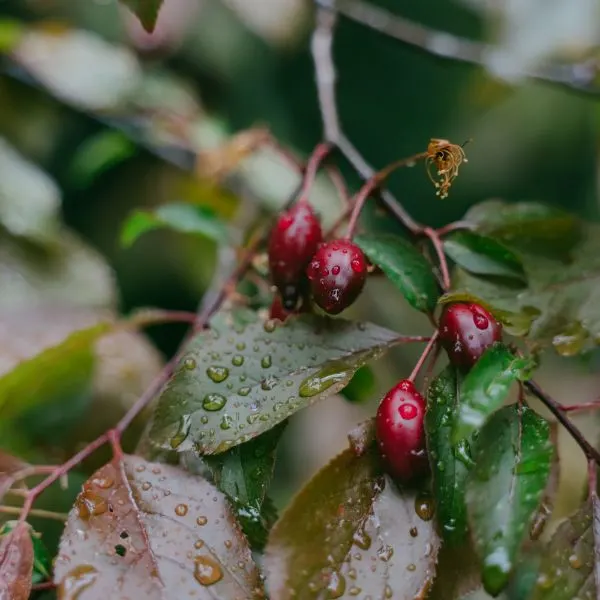
- Botanical Name: Cornus florida
- Sun Requirements: at least 6 hours of exposure to direct sunlight
- Soil Type: moist, acidic soil
Flowering dogwood, also known as American dogwood, is a type of flowering tree in the family of Cornaceae. Flowering dogwood is a tiny deciduous tree spread by seeds. Native Americans utilized the bark and roots as a malaria treatment; a red dye was also taken from the roots.
Azaleas and dogwoods are common garden companions in many regions of the United States, and for a good reason: they are prolific bloomers. The dogwoods produce Autumn colors and fruits that excite the birds, and the evergreen azaleas, as well as those that shed their leaves, contribute to the Autumn color extravaganza.
Planting shade-loving plants together, Azaleas will complement the beauty of your dogwoods by bringing complementary textures, color, depth, and long-term horticultural interest.
Foreign azalea species and variants occasionally have their buds cut by unexpected frosts, and dogwoods have an “off” year. However, for the most part, these are hardy plants that make excellent companions.
13. Ferns
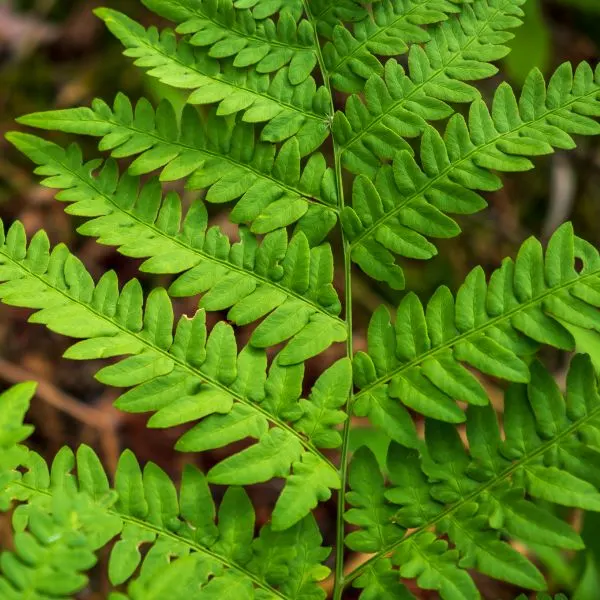
- Botanical Name: Tracheophyta spp
- Sun Requirements: 4 hours per day
- Soil Type: organically rich, loamy soil with good drainage
Ferns are vascular plants (plants with xylem and phloem) that reproduce by spores and do not contain seeds or flowers. Ferns are not as commercially significant as seed plants, but they have historically been utilized in a variety of ways by humans, including as aesthetic plants, household utensils, meals, and in handicrafts.
A variety of ferns, including Hart’s Tongue Fern, Soft Field Fern, Royal Fern, and Painted Lady Fern, will thrive in the presence of azalea plants. Almost all of their preferred environmental requirements and maintenance are similar to those of azaleas. They both prefer wet, rich soils that drain well.
Ferns are exceptionally pH tolerant and may thrive in acidic, alkaline, or neutral soils. As a result, they will thrive in the same acidic soils as azalea plants do. Ferns, with their shape and leaf texture, provide forest beauty. It will be extremely beneficial to plant them with shorter and taller species to fill up empty places in front of and between Azalea plants.
The main distinction here is that ferns may demand more shade than azaleas. However, this is not an issue, and you can easily ensure that they receive more shade than the sun. Azaleas thrive under the shadow of bigger plants and trees, as well as next to ferns. It prefers wet, well-draining soil, which is comparable to that of ferns.
14. Heathers
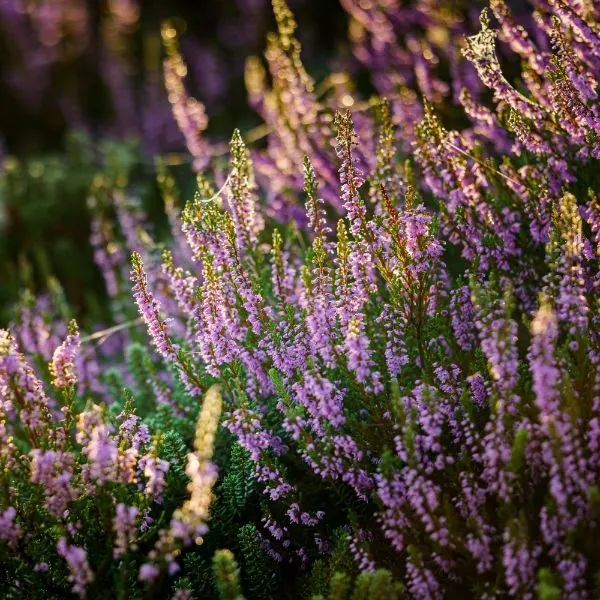
- Botanical Name: Calluna vulgaris
- Sun Requirements: a minimum of six hours of sun a day
- Soil Type: moist but well-drained soil
Heathers is the only species in the flowering plant family Ericaceae’s genus Calluna. Its flower colors range from white to pink to a broad spectrum of purples and reds in different varieties. Heather is a valuable food source for a variety of sheep and deer, who may graze the plant’s tips when snow covers low-growing vegetation.
These plants require the same acidic soil and continuous hydration that heathers do. You may also fertilize heathers and heath with rhododendron meals and get great results.
Mexican heather companion plants include rhododendrons and azaleas. They both flourish in acidic soil and require continuous rainfall. Furthermore, heather can benefit from the same fertilizer as rhododendron. As hedge plants, these flowering shrubs look fantastic with Mexican Heaters.
Consider adding some plants to the covered ground to guarantee optimum moisture and water retention, which will allow both to grow even during the hottest months of the year.
15. Hellebores
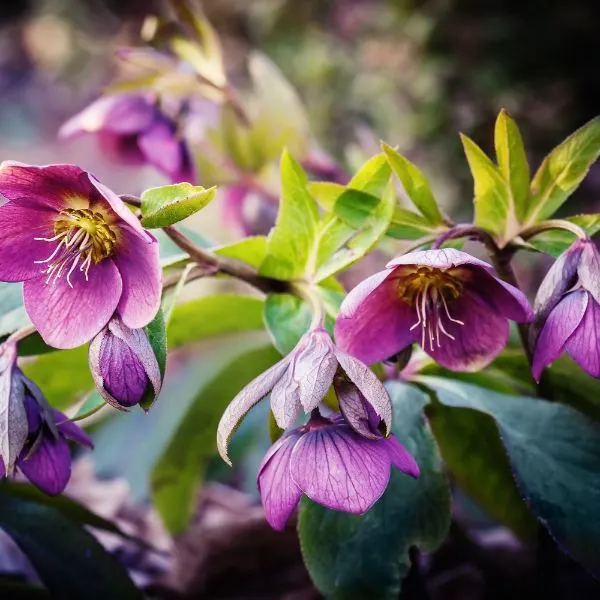
- Botanical Name: Helleborus cyclophyllus
- Sun Requirements: at least 6 hours of exposure to direct sunlight during winter and less during Summer
- Soil Type: Acidic (lime-free) soil
Hellebores are blooming perennial plants that are extensively planted for ornamental reasons in the United States Department of Agriculture hardiness zones 5a to 8b gardens. Gardeners like them for their winter and early spring blooming periods; the plants are remarkably frost-resistant, and many are evergreen. Their shade tolerance is also important.
Hellebores and Azaleas are other combos that work really well together. They both have a wide range of tolerances for soil quality, hydration needs, and light conditions. You cannot go wrong with them as companion plants.
It should be remembered, however, that Hellebores are deadly winter-flowering plants belonging to the buttercup family. It has coarse leaves and blossoms that are white, green, or violet.
16. Holly

- Botanical Name: Ilex aquifolium
- Sun Requirements: 6-8 hours daily
- Soil Type: moist but well-drained soil enriched with lots of organic matter
Holly is the sole extant genus in the Aquifoliaceae family, with approximately 570 species of flowering plants. Many holly species are popular as decorative plants in temperate and European gardens and parks. Holly plants are potentially hazardous to pets and animals.
Holly adds a nice contrast to your azaleas. It features dark green foliage that is evergreen and beautiful red berries. Holly, like azaleas, prefers acidic soil with adequate drainage. Despite the fact that holly attracts mockingbirds and other songbirds, it may also be planted as a shrub or hedge, and there are numerous kinds to select from. These plants are well-known for their glossy spiky green foliage and vivid scarlet berries.
Hollies, like azaleas, require acidic soil and adequate drainage. Another fantastic truth is that your holly discourages mockingbirds and songbirds from feeding on the seeds and blooms of your azaleas.
17. Hostas
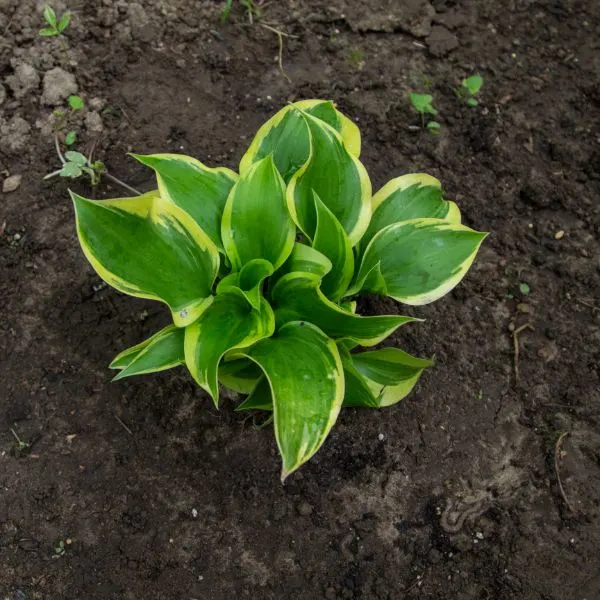
- Botanical Name: Hosta sieboldiana
- Sun Requirements: Two hours of daily sun exposure
- Soil Type: loamy soil-rich organic soil
Hosta is a plant genus that includes hostas and plantain lilies. Hostas are herbaceous perennial plants that are spread by rhizomes. Hosta blooms are produced on woody erect scapes that remain on the plant throughout the winter. Hostas are commonly farmed, and they are especially beneficial in the garden as shade-tolerant plants with eye-catching leaves.
Planting hostas with azaleas adds a luxuriant elegance and beauty to the Azaleas garden. They are slug and snail resistant, which is what every gardener wants, so they help to prevent slugs and snails from entering your azaleas garden.
Hostas are also excellent accent plants for the perennial shadow garden. So you may choose from variegated kinds to add white, yellow, and green tones. All summer long, Hostas offer huge green leaves. They also flourish in partial sun and shade.
18. Hydrangea
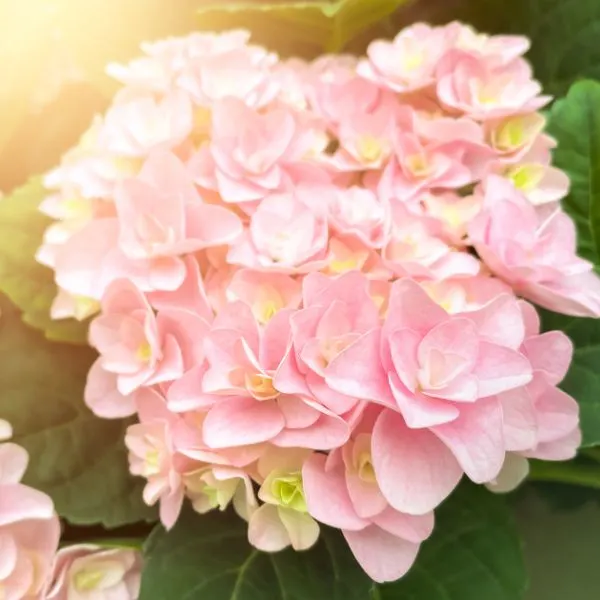
- Botanical Name: Hydrangea macrophylla
- Sun Requirements: six hours of sunlight per day
- Soil Type: Well-drained, alkaline, and acidic soil
Hydrangea is a blooming plant of the Hydrangeaceae family. Common names include big-leaf hydrangea and French hydrangea. Hydrangea flowers come in a variety of colors, including blue, red, pink, light purple, and dark purple. The pH of the soil influences the hue. Hydrangea is used to treat urinary tract issues.
Hydrangeas bloom in a variety of hues during the summer. Hydrangeas, like azaleas, prefer acidic soil and shaded sunshine. Hydrangeas come in a wide spectrum of colors. They attract butterflies, bees, and hummingbirds, making them excellent pollinators. These plants can thrive in most climates and are widely renowned for their magnificent clusters of blooms that vary in color according to the pH of the soil.
Hydrangeas prefer a little more sunshine (but not direct sunlight) than azaleas. This is OK and may be remedied by planting the azaleas behind a pine or oak tree. At the same time, the hydrangeas can be planted just beyond the tree’s shade and shelter.
Both hydrangeas and azaleas may thrive in the shade of pine trees. As a result, it provides an excellent opportunity to fill open space beneath these towering trees! They do, however, require a lot of water to thrive.
19. Japanese Pieris
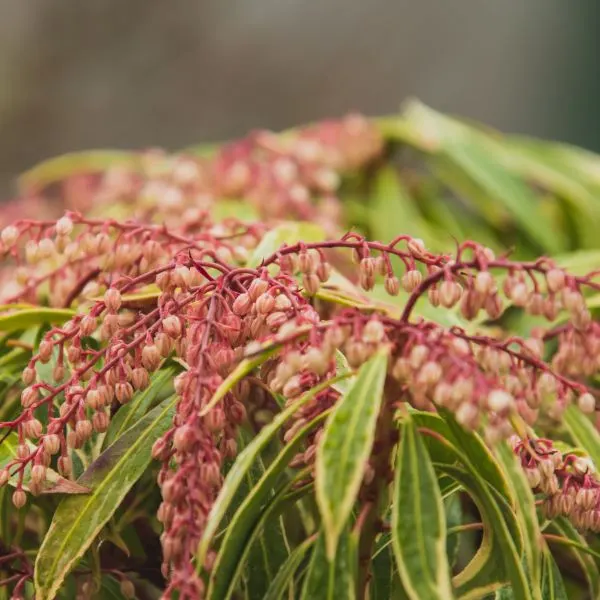
- Botanical Name: Pieris japonica
- Sun Requirements: at least six to eight hours a day
- Soil Type: moist but well-drained, acidic soil
Japanese pieris is a flowering plant of the Ericaceae heath family. It is sometimes referred to as Japanese andromeda. In certain genotypes, the leaves emerge golden or crimson before becoming green—white or pink trusses of little urn-shaped blooms. If humans or animals swallow the plant, they will die. Humans who consume flowers and leaves may experience salivation, headaches, vomiting, heart failure, and death.
Japanese andromeda is hardy and requires little trimming other than to maintain it clean and in form. Azaleas are excellent companion plants for Japanese Pieris since they all prefer acidic soil and bright sunshine. You will enjoy a beautiful riot of color from early spring through late spring.
Also, Pieris, like most azaleas, enjoys early light with afternoon shade, making it an excellent companion plant for Azaleas. This shrub is ideally suited to cultivating in a pot, and it has evergreen foliage that changes color according to the season, making it highly pleasant to the eyes when viewed.
20. Lantanas
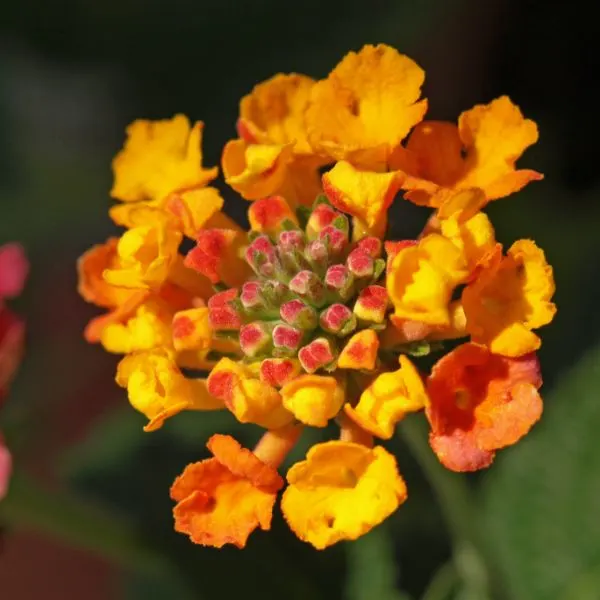
- Botanical Name: Lantana camara
- Sun Requirements: at least six hours (or more) of direct sunlight every day
- Soil Type: wet, well-drained soil made of sand, clay, chalk, or loam with a PH balance of acidic, alkaline, or neutral
Lantana is a genus of over 150 species of perennial blooming plants in the verbena family. They are often known as shrub verbenas or lantanas. The scented flower clusters (called umbels) of lantana are a combination of red, orange, yellow, or blue florets and white florets. Other hues are available when new types are selected. In tropical and subtropical regions, they are commonly planted for their blooms.
When azalea potting soil mixtures are blended with ordinary lantana potting soil at a 50-50 ratio, they give the acidity that lantanas love, making Lantanas suitable companion plants for Azaleas. Lantanas also enjoy warm temperatures and should be planted after any threat of frost or cold weather.
21. Mountain laurels

- Botanical Name: Kalmia latifolia
- Sun Requirements: minimum of 6–8 hours of direct, unfiltered sunlight each day
- Soil Type: cool, moist but well-drained, acidic soil (pH 5.0 to 5.5)
Mountain laurel, also known as calico-bush or spoonwood, is a flowering plant of the heath family Ericaceae. It is an evergreen shrub with hexagonal, occasionally pentagonal blooms that range from light pink to white and emerge in bunches. Although Mountain laurel is deadly to various animals, it was initially imported to Europe as a beautiful shrub.
Mountain laurel is one of the members of the heath family, along with rhododendron, azalea, and blueberry. This makes it an excellent azalea companion plant. They have thick, glossy leaves that keep deer and rabbits away. This thick, bushy shrub with lustrous evergreen foliage also has enormous clusters of beautiful blossoms.
The heath family also includes rhododendron, azalea, and blueberry. Mountain laurel is the finest member of this family. This makes it an excellent azalea companion plant. So pairing mountain laurel with azaleas will make it act as a protection for your azalea plant!
22. Nannyberry
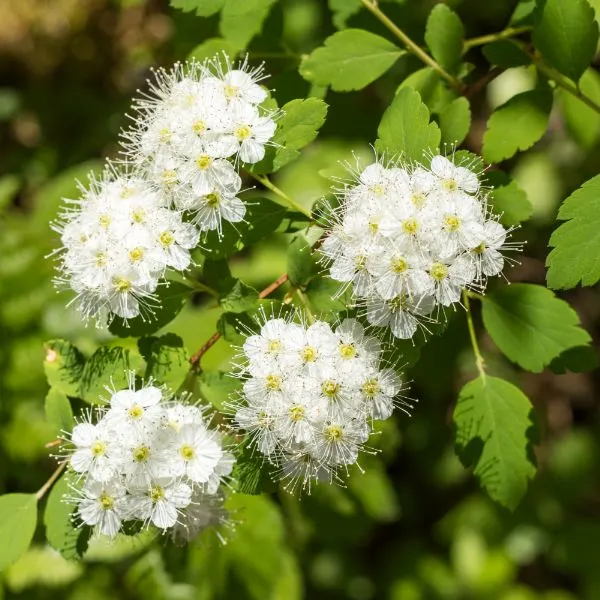
- Botanical Name: Viburnum lentago
- Sun Requirements: only 2-6 hours of direct sunlight a day
- Soil Type: average, medium moisture, well-drained soils
The nannyberry, also known as sheepberry or sweet viburnum, is a Viburnum species endemic to North America. It is a tiny tree or shrub with five pale petals grouped in a big spherical terminal. The fruit is edible (unlike many viburnums), as implied by the alternate name sweet viburnum.
Native Americans also employed the bark and leaf in the manufacture of herbal remedies.
Nannyberry is a drought-tolerant shrub with white blossoms that bloom in the fall. The shrub will bear a huge amount of berries once the blooms have fallen.
23. Ninebark

- Botanical Name: Physocarpus opulifolius
- Sun Requirements: a minimum of 6 hours; 8 or more is ideal.
- Soil Type: moderately moist, well-draining soil with a pH that is neutral to slightly acidic
Ninebark, sometimes known as Eastern ninebark, Atlantic ninebark, or just common ninebark, is a flowering plant in the Rosaceae family. It’s a mound-shaped deciduous shrub with simple, alternating leaves on arching stems. Its capacity to grow in tough environments makes it ideal for bank erosion management. However, it is also planted for its decorative leaves.
Ninebark is a deciduous shrub with dark-green or crimson foliage that arches and cascades. It contains clusters of flowers and crimson fruit that birds like. Planting it alongside azaleas will enhance the visual attractiveness of the garden, and they both thrive in well-drained, acidic soil. They make excellent companion plants for one another.
However, where you plant them next to ninebarks varies depending on the size of both bushes, so I recommend cultivating a tiny azalea type so that it does not overwhelm the ninebark, especially because the azaleas have showier blossoms.
24. Red Oak
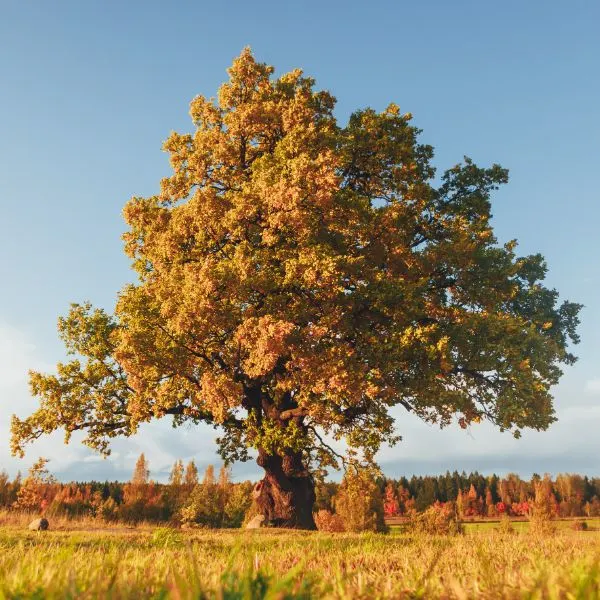
- Botanical Name: Quercus rubra
- Sun Requirements: 4 to 6 hours daily
- Soil Type: acidic, loamy, moist, sandy, well-drained, and clay soils
Northern red oak is an oak tree of the red oak group. It is easily identified by its bark, which contains ridges that appear to have glossy stripes along the middle. The northern red oak is one of the most significant oaks in North America for wood production. Quality red oak timber and veneer are highly valued, whereas faulty logs are utilized as fuel.
Red oak trees benefit from the presence of azaleas. It is vital not to place them too near to the trunk since they require some sunlight to flourish. Their height is the most significant advantage that benefits the azalea plants. Azalea bushes grow only when they get adequate sun and shade, and placing it not too close to red oak will meet that criterion.
Red oak is also a pollution-tolerant tree that is useful in urban and suburban landscaping and can thrive in a variety of soil pHs, including acidic soils. Also, keep in mind that azaleas can reach heights of up to 10 feet. Planting beneath oak trees should be done with shorter types, especially if your oak has many lower-hanging limbs.
Both trees are noted to have poorly distributed leaves on their branches. This allows the sun to travel between the leaves, creating a dappled light pattern.
25. Onions
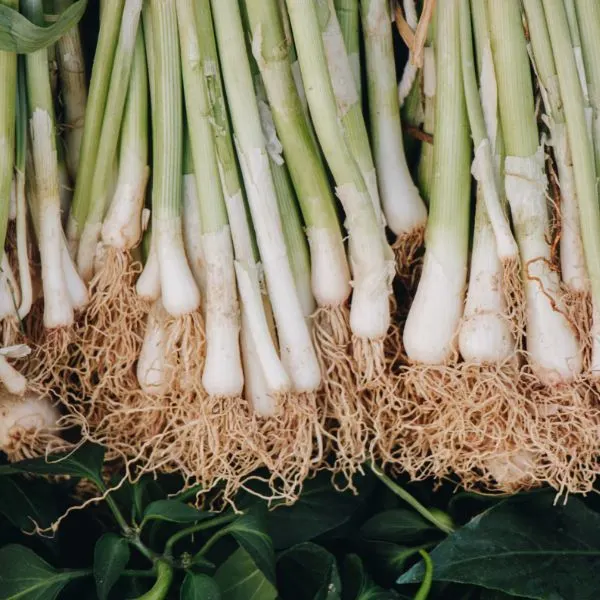
- Botanical Name: Allium cepa
- Sun Requirements: a minimum of 11 hours daily
- Soil Type: well-drained soil with pH between 6.0 and 7.0, and high organic matter
An onion is a vegetable that is the most frequently grown member of the genus Allium. It is also known as the bulb onion or common onion. The bulb at the base of the onion plant starts to expand after a certain day length is reached. The onion plant has hollow, bluish-green leaves. This genus also comprises numerous additional species that are farmed for food and are known as onions. The crop is collected and dried, and the onions are ready for use or storage.
Ornamental onions are members of the Allium genus, which includes onions, leeks, scallions, garlic, chives, and other plants. Alliums are excellent companion plants for other spring flowers, such as Azaleas, since they serve to discourage pests that might infect azaleas, thus increasing the appearance of your azalea garden.
26. Oregon Grape Holly
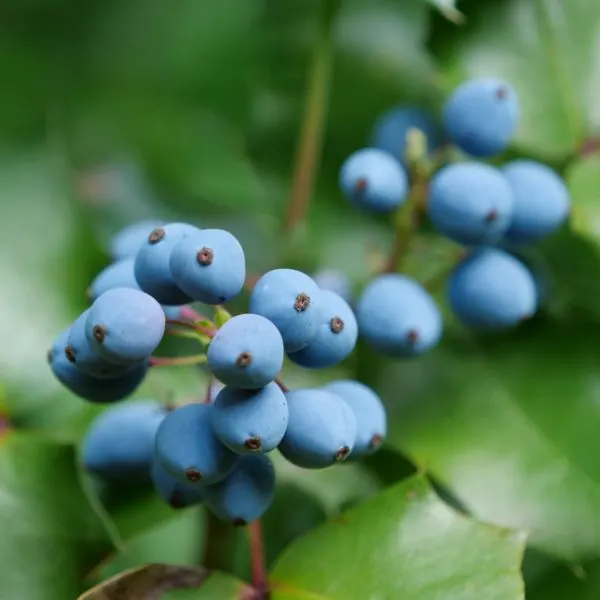
- Botanical Name: Mahonia aquifolium
- Sun Requirements: 4-6 hours daily
- Soil Type: humus-rich, slightly acidic, evenly moist but well-draining garden soil
The Oregon grape, also known as the holly-leaved barberry, is a flowering plant in the Berberidaceae family. It is admired for its attractive leaves and blooms, which typically arrive before those of other shrubs. After the first frosts of the season, the little purplish-black fruits, which are fairly acidic and contain big seeds, are eaten uncooked.
Azaleas require regular moisture to create leaves, which Oregon grape holly provides, making both plants excellent companion plants. Oregon grape holly is a hardy, drought-tolerant shrub. It is available as an erect shrub or in a trailing form, and it does not produce a lot of leaf litter, which makes it extremely appealing in the garden.
27. Ornamental Grasses
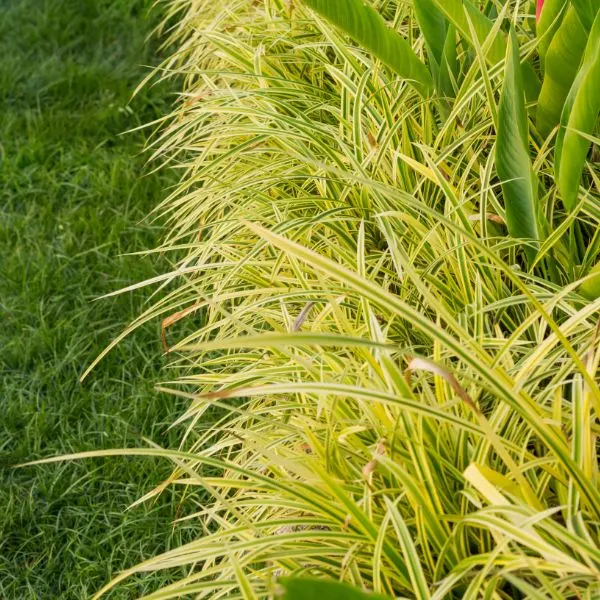
- Botanical Name: It is variant dependent.
- Sun Requirements: at least six hours of sunlight per day
- Soil Type: light, moist but free-draining, moderately fertile soil
Decorative grasses are grasses grown for their ornamental value. Almost all ornamental grasses are perennials that sprout in the spring from roots that have stored a lot of energy and then die in the fall or winter. Cloud grass, Feather reed grass, Crimson fountain grass, deer grass, and other species are among them.
Ornamental grass is an excellent companion plant for azaleas since it does not overpower them. They are equally appealing in their own way, and people will not be obliged to choose the ‘prettier flowers.’ These plants are not fussy about their soil requirements. They may thrive in poor or fertile soil, but they must have sufficient drainage. They require more sunlight than azaleas. Furthermore, the decorative grass can aid in shading the azalea from direct sunlight.
28. Pine Trees
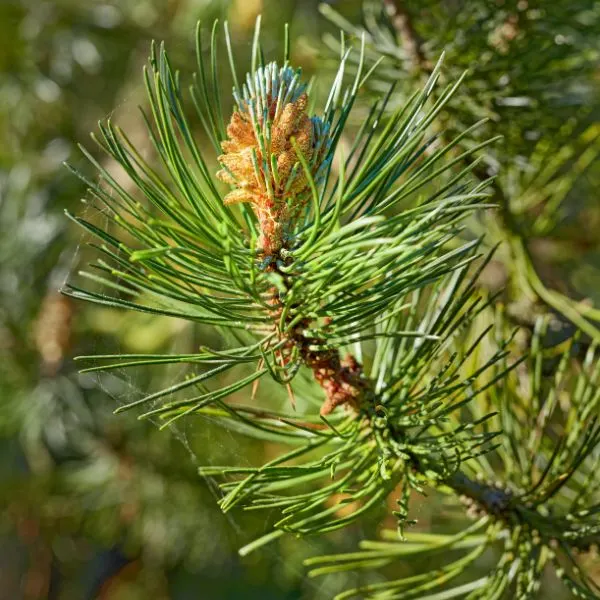
- Botanical Name: Pinus sylvestris
- Sun Requirements: at least six to eight hours of sunlight daily
- Soil Type: well-drained sandy soil where nutrients are readily available
A pine is any conifer tree or shrub of the genus Pinus in the Pinaceae family. Pine trees are evergreen, resinous coniferous trees. Pine may also refer to timber made from pine trees; it is one of the most often used forms of lumber.
Pines are among the most commercially significant tree species in the world, prized for their timber and wood pulp. Many pine species make appealing decorative plants for parks and big gardens, and dwarf versions are available for smaller places.
Pine trees and oak trees both thrive under bright sunshine. This is ideal since they prevent direct sunshine from draining the azaleas. Both trees can live in soils with varied pH levels, including acidic soils. As a result, Pine is an excellent companion plant for Azaleas.
Azalea roots are shallow, so they don’t compete with pine trees for moisture and nutrients. Azaleas are excellent companion plants for pine trees as long as they are not exposed to direct sunlight and have enough acidic soil.
When trimming azaleas, it is best to keep the pruning mild. Azalea flower output might be affected by heavy trimming for a few years. Because azaleas are slow-growing shrubs, and trimming might disrupt bloom output, most people leave them alone.
29. Sedges
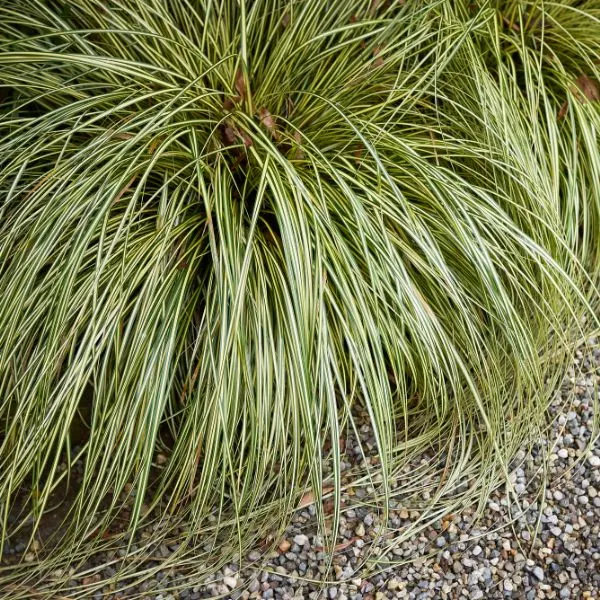
- Botanical Name: Cyperaceae spp
- Sun Requirements: at least 6 hours of sunlight in the day
- Soil Type: moist soil, boggy ground, or shallow water
Sedges are a graminoid (grass-like), monocotyledonous flowering plant family having stems with triangle cross-sections that distinguish members of the sedge family from grasses or rushes. Some well-known sedges are the water chestnut and the papyrus sedge, from which the writing material papyrus was derived.
Sedge plants have strappy leaves that mimic several forms of grass. It is a perennial plant that reproduces by seeds and rhizomes. They thrive in chilly temperatures and go dormant in the hot heat. When planted with Azaleas, they both look excellent next to each other and have comparable growing conditions, making them good companion plants.
30. Snowball bush
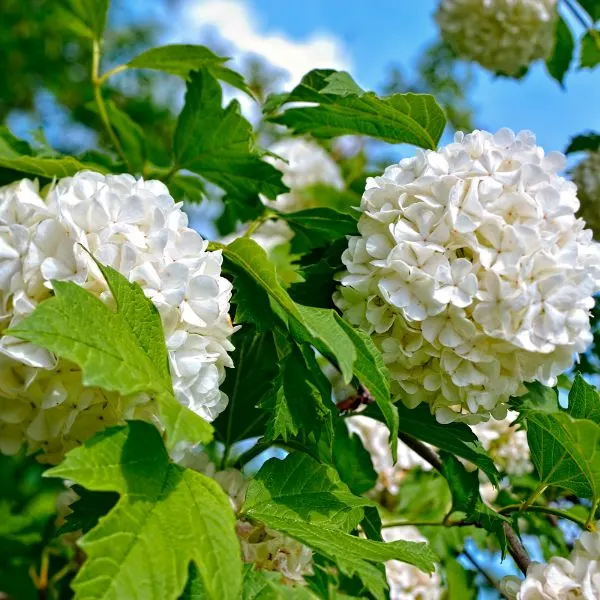
- Botanical Name: Viburnum acerifolium
- Sun Requirements: at least six hours of sunlight per day
- Soil Type: well-drained, loamy soil
Snowball bush is a Viburnum species with a diverse fall color manifestation that can range from pale yellow to bright yellow to orange, pink, rose, or red-purple based on light exposure and climatic circumstances. The blooms are white with five little petals, and the leaves are fashioned like maple leaves. Their berries may be converted into jam and are available from late summer through October.
The Snowball Bush, also known as viburnum, has spectacular balls of white blooms. They’re easy to cultivate and don’t take much care in your azalea garden. This plant thrives in filtered sunshine and acidic soil. They’re great for pollinator gardens and are resistant to foraging animals.
They don’t require much maintenance and are simple to grow in your azalea garden. This plant, like azaleas, requires acidic soil and dappled sunlight, making it an ideal companion plant for Azaleas. They are resistant to foraging animals and are ideal for pollinator gardens. Planting them near your azaleas can help them flourish securely.
31. Soapwort
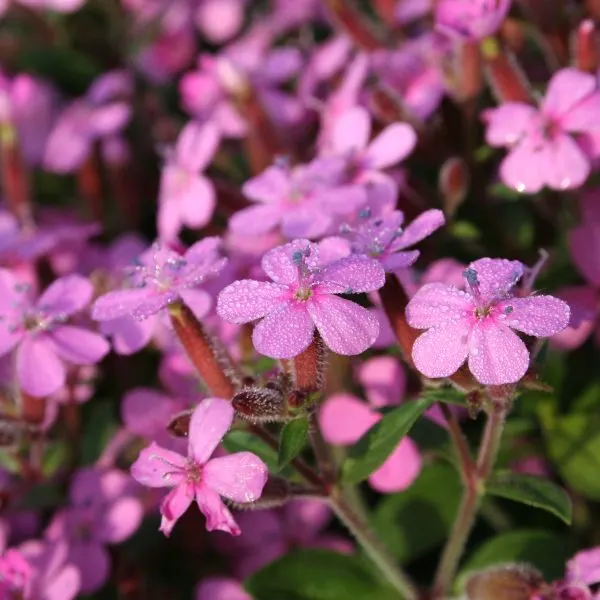
- Botanical Name: Saponaria ocymoides
- Sun Requirements: a minimum of 6 hours of sunlight
- Soil Type: lean, well-drained soils
Soapwort is a semi-evergreen perennial blooming plant of the Caryophyllaceae family. They are herbaceous perennials and annuals, with some having woody roots. The blooms are many, five-petaled, and generally pink or white. Bronchitis, cough, and irritation of mucous membranes in the lower and upper respiratory tract are all suggested applications for soapwort
Soapwort is a perennial plant with tall stems bearing oval leaves and scented pale pink or white flowers. It is a great addition to any slightly shaded landscape and may even be seen in an Azalea garden. They also add to the attractiveness of the garden with their blossoms, which complement Azalea flowers.
32. Spotted dead nettle

- Botanical Name: Lamium maculatum
- Sun Requirements: at least three to four hours of sunlight daily
- Soil Type: average, medium moisture, humus-rich, well-drained soils
The spotted dead nettle (also known as spotted henbit and purple dragon) is a flowering plant in the Lamiaceae family. It is prostate, spreading herbaceous perennial with varying leaf size and form, hairiness, and flower colors. The dried leaves have been used as a poultice to treat stem hemorrhaging, whilst the fresh bruised leaves can be utilized to treat exterior cuts and wounds.
When placed next to a beautiful blooming azalea, the silver leaf of spotted dead nettle stands out. Because it covers empty spaces with beautiful ground cover, it’s perfect for planting around azalea bushes and other companion shrubs. This makes it a perfect Azalea companion plant.
33. Summer Sweet
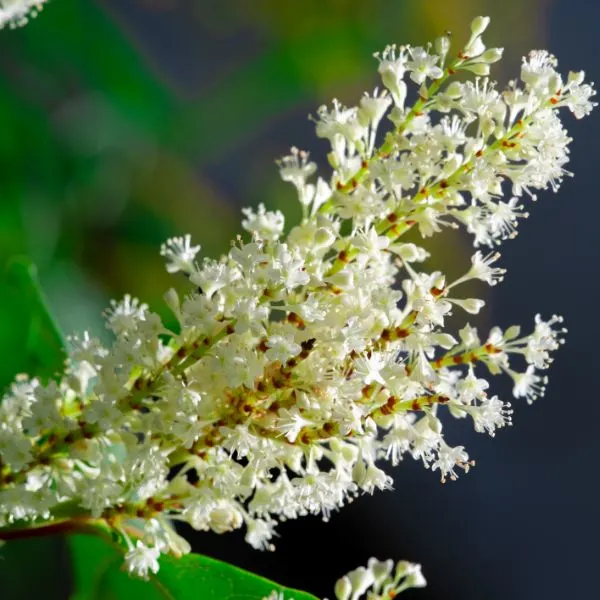
- Botanical Name: Clethra alnifolia
- Sun Requirements: at least 6 hours of sunlight per day
- Soil Type: acidic, sandy soil that is moist but will tolerate clay soils
Summersweet, also known as coastal sweet pepper bush and clethra, is a flowering plant in the genus clethra of the Clethraceae family. It is a deciduous shrub with green leaves that turn yellow-golden in the autumn. It is commonly utilized as a shrub in natural gardens or to slow erosion near a stream or pond.
These shrubs are good azalea companions. They blossom in the spring because they bloom in late summer in large clusters of white or pink blooms. Summersweet prefers acidic soil with adequate drainage. It attracts pollinators like hummingbirds, butterflies, and bees.
34. Tulips

- Botanical Name: Tulipa gesneriana
- Sun Requirements: a minimum of 6 hours daily
- Soil Type: fertile, well-drained neutral to alkaline soil, full of organic materials
Tulips (Tulipa) are a genus of perennial herbaceous bulbiferous plants that bloom in the spring (having bulbs as storage organs). The blooms are often huge, showy, and highly colored, ranging from red to pink to yellow to white (usually in warm colors). Tulip petals can be eaten. The flavor varies according to type and season, but it is comparable to lettuce or other salad greens. Some people, however, are allergic to tulips.
Tulips are an excellent early spring companion plant for Azaleas due to their complementary color. They thrive in similar circumstances as azaleas and may be placed in front of or interspersed with them, making your landscape seem extremely attractive in any case.
However, you should be aware that tulips are harmful to domestic animals such as horses, dogs, and especially cats, so keep your pets and animals away from them.
35. Witch Hazel
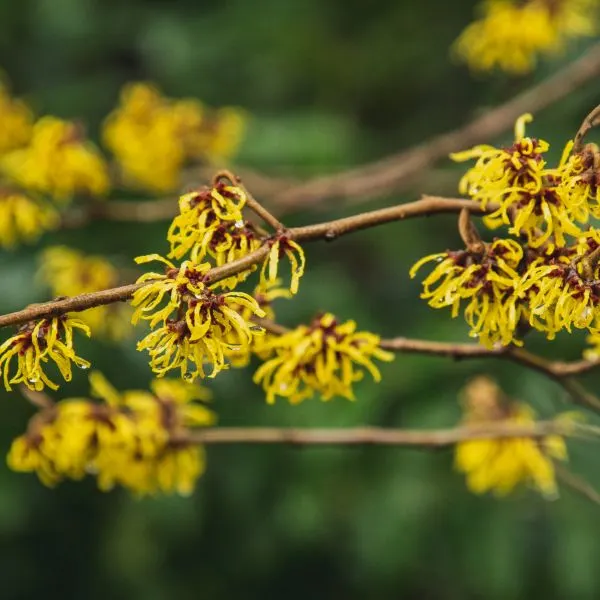
- Botanical Name: Hamamelis mollis
- Sun Requirements: six hours of sunlight a day
- Soil Type: neutral to slightly acid soil with good drainage, especially during summer
Witch Hazel, also known as Chinese witch hazel, is a flowering plant in the Hamamelidaceae family. The witch-hazels are large deciduous shrubs or (rarely) small trees that are widely cultivated as ornamental plants, valued for the strongly-scented flowers that appear in winter when little else is growing.
Witch hazels come in a variety of sizes, from enormous bushes to little trees. They are wonderful azalea companion plants since they have neutral summer leaves that turn golden in the fall. They also have small blooms that bloom in the fall, making them an excellent complement to an azalea landscape. They make great azalea companion plants. In the fall, their neutral summer foliage becomes golden. They are a lovely addition to an azalea garden since they offer little flowers in the fall.
Bad Companion Plants For Aazaleas
1. Black Walnut
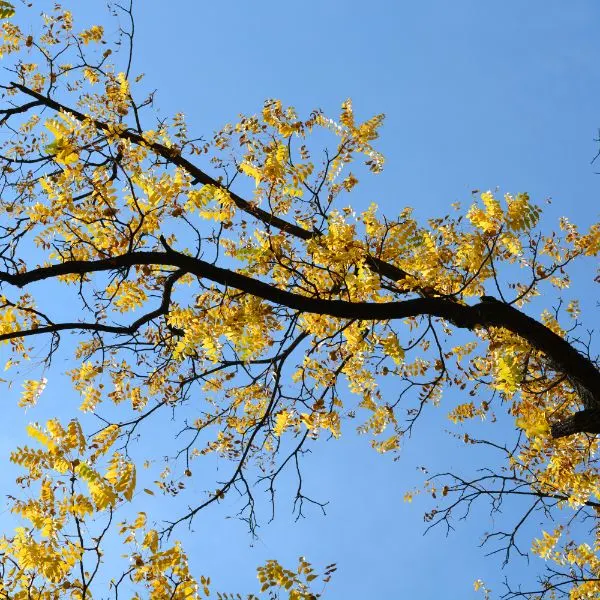
Black walnuts are a poor companion plant due to the material released by their trees, which inhibits the growth of other trees or plants. Unfortunately, azaleas are also susceptible to this toxin. Juglone is the chemical produced by the black walnut tree. It is highly concentrated in the nuts, hulls, and roots. Juglone is found in lesser proportions in the leaves and stems. As a result, Black walnut is a poor plant to put near Azaleas.
2. Lavender
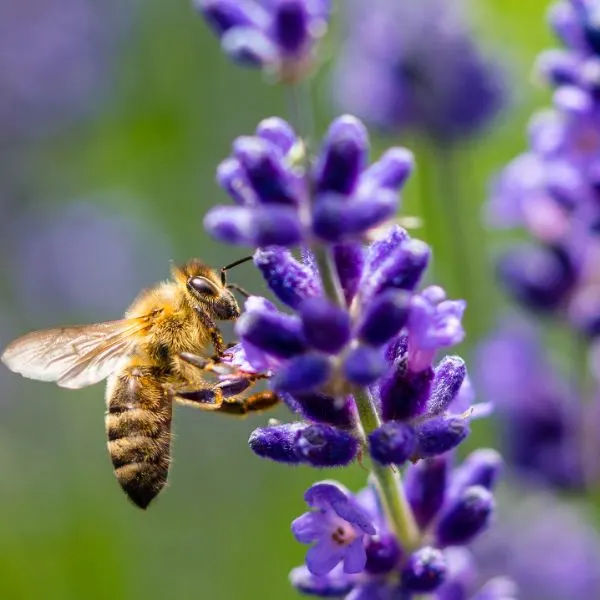
Lavender is a herb that also has beautiful blossoms. Lavender with azaleas may appear to be a pleasant sight, but this is not the case. Lavender favors alkaline soil, prefers dry soil, and requires more sunlight and little shadow, whereas azalea prefers acidic soil, prefers wet soil, and can withstand more shade.
As their only requirement in common is well-draining soil, these two plants cannot grow together. Due to variations in environment and care, growing them together would result in one of them dying.
Lavender does work well with plenty of other plants though.
FAQs
For gardeners aiming for a beautiful garden with azaleas, understanding the bloom time, soil conditions, and the benefits of evergreen plants like hydrangea quercifolia and maidenhair fern can make all the difference. Incorporating Japanese maples can add a stunning backdrop to your azalea plantings, ensuring a garden with visual interest throughout the growing season.
When should you not trim azalea bushes?

After flowering, azaleas can be lightly pruned to remove any diseased material. Evergreen azaleas should not be pruned at the end of summer or in the fall ‘because you want to avoid cutting off fall-produced flower buds that will be next spring’s blooms,’ they add. Azalea pruning should therefore be completed by mid-summer.
Do azaleas need to be covered?
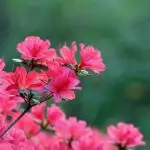
Many plants, such as azaleas, pansies, and hollies, can survive without any protection.
How do you prepare the soil for azaleas?

Azaleas thrive in moist, acidic (pH 5.5 or higher), well-drained soil rich in organic matter such as peat, compost, chopped leaves, or ground bark. They are not capable of growing in heavy clay, pure sand, or alkaline soil. Plant azaleas in raised beds or containers if your existing soil is too poor to repair.
What is the best mulch for azaleas?

The material used for mulches should be sourced locally. Pine bark nuggets are widely available in states where pine trees are commonly harvested. Pine needles can be used as well. Both of these add a bit of acidity to the soil as they decompose over the winter, which is ideal for azaleas.
What is the best position to plant an azalea?
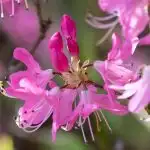
They will not bloom if planted in thick shade. An excellent site is one where they get either all-day dappled sun or sun in the morning and little shade in the afternoon. Locations under trees or along the north side of your house may be suitable.
What is the best time to plant azaleas?

Azaleas are best planted in late spring or early fall. They will give you beautiful blossoms the following spring if you take the correct steps to get them started.
Do azaleas do well in pots?

The fact that azaleas have fine, fibrous root systems implies that plants may live happily in pots for many years. Even enormous bushes flourish in them, but young plants will need to be moved up into larger pots as they mature.
Wrapping up
Incorporating the right companion plants, such as hydrangea plants, for their foliage color and a pop of color, alongside azaleas can transform your garden into a space with beautiful contrasts and year-round interest. Remember, the best plants for your garden will thrive under the same light and soil conditions, offering a variety of different colors and textures that complement each other perfectly.
Azaleas are blooming shrubs in the genus Rhododendron, and we were able to examine thirty-five (35) good companion plants and two (2) bad companion plants to see how they impact the growth and development of Azaleas when planted alongside them. Aside from its beauty, the azalea is also exceedingly dangerous, with andromeda toxins found in both its leaves and nectar, including honey made from the nectar.
Azaleas have the advantage of requiring little care and maintenance once established. Fertilizer is usually unnecessary for established plants. It is also a useful plant that gives advantages such as air purification, hypertension reduction, skin radiance, pollinator attraction, and so on.
Although all parts of the Azalea plant are highly poisonous, they are used topically to cure ailments such as arthritis, cavities, itch, maggots, and severe injuries. And their unrestrained growing habit adds architectural interest throughout the year and looks lovely when coupled with other plants that flourish in the same circumstances.
Azalea bushes are best planted as container-grown nursery plants in the spring or early fall. Growth rates vary per species, although the majority develop slowly. A one-gallon plant will usually blossom in its first year, but it may take up to ten years to reach full size. These plants are normally relatively easy to cultivate in a suitable site, but they may be rather temperamental if conditions aren’t quite to their liking.
Most importantly, the soil must be loose, well-draining, and somewhat acidic in pH. Azaleas are frequently planted in artificial berms built by bringing in loose, porous dirt to create raised planting spaces in places with thick soil.
More plant stuff
